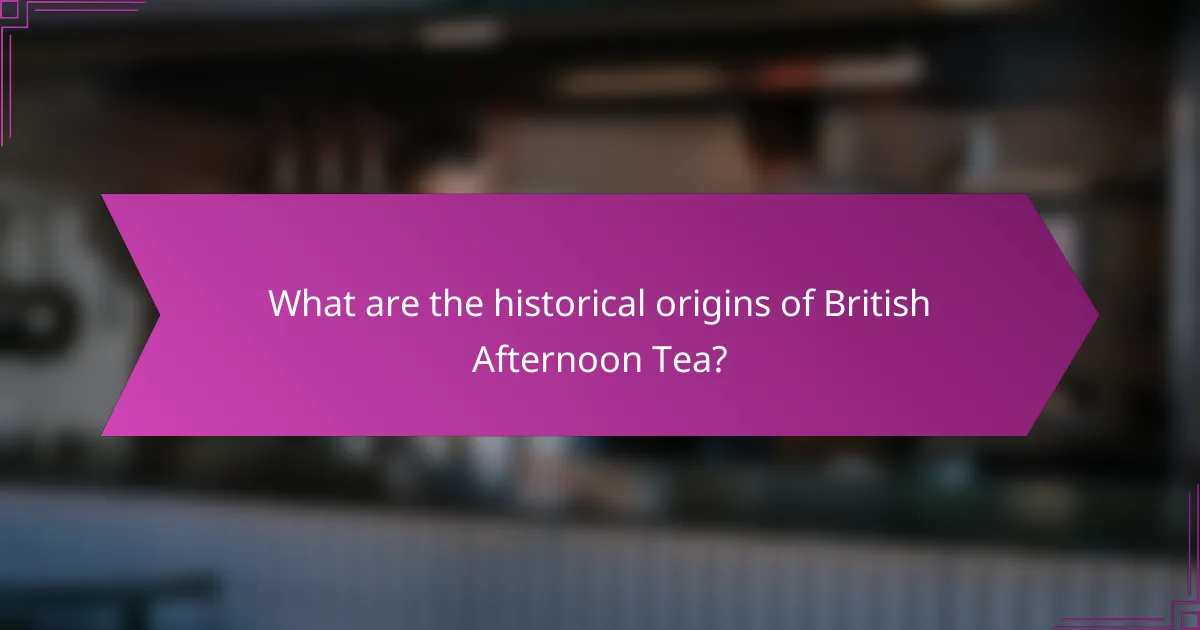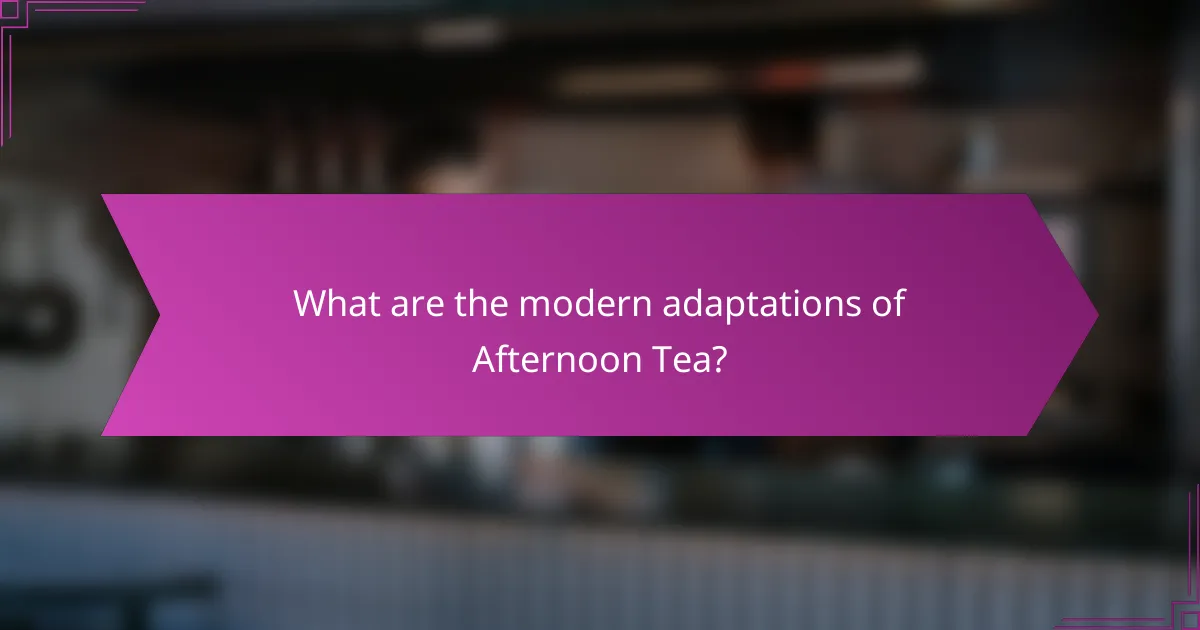British Afternoon Tea offers a delightful cultural experience that combines tradition with social interaction. Explore its historical origins, essential components like tea and pastries, and the etiquette that enhances the occasion. Discover modern adaptations that cater to diverse tastes and learn how to avoid common mistakes for an enjoyable experience.

What are the historical origins of British Afternoon Tea?
British Afternoon Tea originated in the early 19th century, attributed to Anna, the Duchess of Bedford. She introduced this practice to combat hunger between meals. The custom quickly gained popularity among the British aristocracy. It evolved into a social event featuring tea, sandwiches, scones, and pastries. The tradition solidified in the Victorian era, emphasizing etiquette and presentation. Today, it remains a cherished cultural ritual.
How did social customs influence the evolution of Afternoon Tea?
Social customs significantly shaped the evolution of Afternoon Tea, establishing its role as a social event. In the 19th century, the British upper class adopted Afternoon Tea as a means to bridge the gap between lunch and dinner. This practice became a fashionable gathering, emphasizing social status and refined etiquette. The introduction of tea served with light snacks reflected cultural norms around hospitality and leisure. As a result, Afternoon Tea evolved into a structured event with specific rituals, such as the use of fine china and the wearing of elegant attire, further reinforcing social hierarchies.
Which notable figures popularized Afternoon Tea in Britain?
Queen Victoria significantly popularized Afternoon Tea in Britain during the 19th century. Anna Maria Russell, the Duchess of Bedford, also played a crucial role by introducing the practice as a social event. Their influence helped establish Afternoon Tea as a cherished British tradition, emphasizing elegance and social interaction.

What are the essential components of a traditional Afternoon Tea?
Traditional Afternoon Tea consists of several essential components: a selection of teas, finger sandwiches, scones with clotted cream and jam, and an assortment of pastries and cakes. These elements reflect the cultural significance of this British tradition, emphasizing quality and presentation. The tea variety typically includes black teas like Earl Grey or Assam, while the sandwiches often feature cucumber, smoked salmon, and egg mayonnaise. Scones serve as a highlight, offering a delightful contrast with their sweet and savory accompaniments. Pastries and cakes add a finishing touch, showcasing creativity and indulgence.
What types of tea are commonly served during Afternoon Tea?
Common types of tea served during Afternoon Tea include black tea, green tea, and herbal tea. Black tea varieties such as Earl Grey and Darjeeling are traditional favorites. Green tea offers a lighter option, while herbal teas like chamomile provide caffeine-free choices.
Which food items are typically included in an Afternoon Tea setting?
An Afternoon Tea setting typically includes a variety of food items such as finger sandwiches, scones with clotted cream and jam, and an assortment of pastries and cakes. Finger sandwiches often feature fillings like cucumber, smoked salmon, or egg salad. Scones are a signature element, served warm and accompanied by rich clotted cream and strawberry jam. Pastries and cakes can vary widely, often showcasing seasonal fruits or classic British recipes.
How does the presentation of Afternoon Tea vary regionally?
The presentation of Afternoon Tea varies regionally, reflecting local customs and ingredients. In England, it typically includes a selection of sandwiches, scones, and pastries. In Scotland, you may find oatcakes and shortbread. Regions like the West Midlands emphasize savory items, while the South often features fruit-based desserts. In contrast, places like Hong Kong incorporate dim sum elements, showcasing a blend of British and Chinese traditions. Each variation highlights unique cultural influences and preferences.

What etiquette should be observed during Afternoon Tea?
During Afternoon Tea, it is essential to observe proper etiquette to enhance the experience. Begin by arriving on time, as punctuality is valued. Use polite language and engage in light conversation, avoiding controversial topics. When consuming food, use utensils appropriately and refrain from reaching across the table. Always wait for the host to invite you to begin, and take small bites to maintain decorum. Lastly, express gratitude to the host for the invitation and the meal.
What are the key rules for serving and enjoying Afternoon Tea?
To serve and enjoy Afternoon Tea, follow these key rules: select a suitable time, typically between 3 PM and 5 PM, use fine china for presentation, and serve a variety of teas alongside sandwiches, scones, and pastries. Maintain a relaxed atmosphere, engage in light conversation, and observe proper etiquette, such as not rushing the experience. Enjoying Afternoon Tea emphasizes savoring flavors and appreciating the social interaction.
How do cultural variations influence Afternoon Tea etiquette?
Cultural variations significantly shape Afternoon Tea etiquette through differing customs and practices. In Britain, Afternoon Tea is a formal event with specific rules, such as the order of food service and the use of fine china. In contrast, countries like Japan incorporate tea ceremonies that emphasize mindfulness and ritual, altering the focus from food to the tea itself. Additionally, in the United States, Afternoon Tea may be more casual, often featuring a wider variety of food and a relaxed atmosphere. These cultural nuances reflect unique attributes of each tradition, influencing how Afternoon Tea is experienced globally.

What are the modern adaptations of Afternoon Tea?
Modern adaptations of Afternoon Tea include themed events, casual settings, and diverse culinary influences. These variations cater to contemporary tastes while retaining traditional elements. For instance, some venues offer vegan or gluten-free options, expanding accessibility. Others incorporate local flavors, creating unique experiences that reflect regional cuisine. Additionally, Afternoon Tea is now often served in less formal environments, such as cafes and restaurants, making it more approachable for a wider audience.
How have contemporary trends transformed the traditional Afternoon Tea experience?
Contemporary trends have modernized the traditional Afternoon Tea experience by introducing diverse flavors and innovative presentations. This evolution reflects a shift towards inclusivity, featuring vegan and gluten-free options to cater to various dietary preferences. Additionally, the setting has transformed, with many establishments offering themed teas and unique pairings, enhancing the overall experience. Social media influences have also played a role, promoting visually appealing setups that attract a younger audience.
Which unique themes are emerging in Afternoon Tea offerings?
Emerging themes in Afternoon Tea offerings include innovative flavor pairings, plant-based options, and immersive experiences. These trends reflect a shift towards sustainability and personalization in this traditional ritual. Unique attributes like themed presentations and local ingredient sourcing enhance the overall experience.

What are the health benefits associated with Afternoon Tea?
Afternoon tea provides various health benefits, including improved hydration, enhanced social interaction, and potential weight management. The practice encourages mindfulness, as savoring tea and treats can reduce stress levels. Furthermore, certain teas, like green or herbal varieties, offer antioxidants that support overall health.
How can Afternoon Tea contribute to social bonding and well-being?
Afternoon tea fosters social bonding and well-being by creating a relaxed atmosphere for conversation and connection. It encourages mindfulness through the ritual of tea preparation and consumption. Sharing food enhances feelings of community, promoting emotional support. Engaging in this tradition can reduce stress and improve overall mental health. The unique setting of afternoon tea cultivates meaningful interactions, reinforcing social ties.
What nutritional considerations should be taken into account?
Nutritional considerations for British Afternoon Tea include balancing calorie intake, selecting nutritious tea options, and incorporating healthy snacks. Afternoon tea typically features finger sandwiches, pastries, and scones, which can be high in calories and sugar. Opting for whole grain bread and fresh fruits can enhance nutritional value. Additionally, herbal teas offer antioxidants while minimizing caffeine consumption.

What common mistakes should be avoided during Afternoon Tea?
To enjoy British Afternoon Tea, avoid common mistakes such as poor timing, neglecting etiquette, and selecting inappropriate food pairings. These errors can diminish the experience and fail to honor the tradition.
1. Serving tea at the wrong temperature can affect flavor.
2. Ignoring the correct order of courses disrupts the flow.
3. Using non-traditional tea blends may confuse guests.
4. Failing to provide adequate utensils leads to discomfort.
5. Overcomplicating the menu can overwhelm attendees.
6. Neglecting to dress appropriately may seem disrespectful.
How can one ensure a successful Afternoon Tea experience?
To ensure a successful Afternoon Tea experience, focus on selecting quality tea, fresh pastries, and a suitable setting. Consider the following essential components:
1. Choose a variety of fine teas, such as Earl Grey or Darjeeling, to cater to different tastes.
2. Serve a selection of delicate sandwiches, scones with clotted cream and jam, and an assortment of pastries.
3. Create a pleasant atmosphere with elegant table settings, including fine china and fresh flowers.
4. Follow proper etiquette, such as holding teacups correctly and engaging in polite conversation.
These elements contribute to an enjoyable and memorable Afternoon Tea gathering.
What tips do experts recommend for hosting Afternoon Tea?
Experts recommend several key tips for hosting a successful Afternoon Tea. First, select a suitable venue, ideally a well-lit space with comfortable seating. Second, prepare a diverse menu featuring traditional components like finger sandwiches, scones with clotted cream and jam, and an assortment of pastries. Third, choose high-quality teas, offering a variety of flavors and strengths to cater to guests’ preferences. Fourth, pay attention to presentation; use elegant tableware and decorative elements to enhance the experience. Finally, observe proper etiquette, including serving tea from the left and ensuring guests are comfortable throughout the event.



